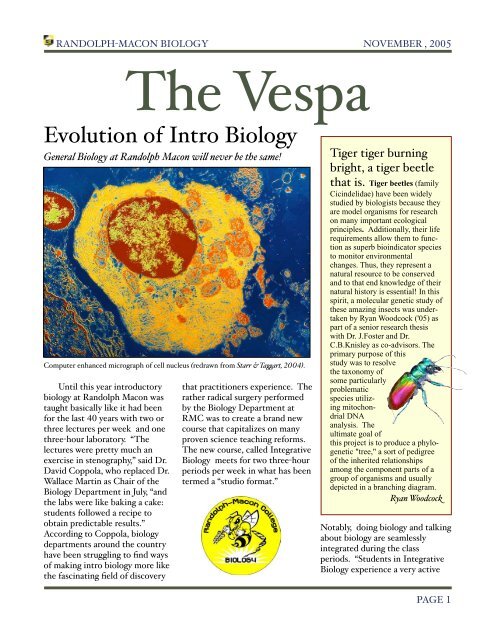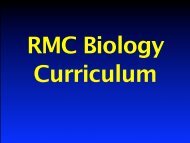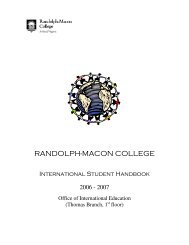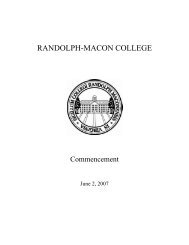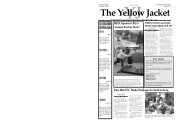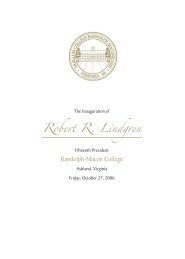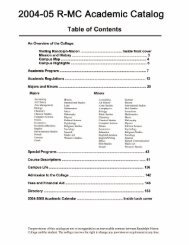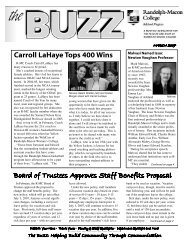The Vespa - Randolph-Macon College
The Vespa - Randolph-Macon College
The Vespa - Randolph-Macon College
Create successful ePaper yourself
Turn your PDF publications into a flip-book with our unique Google optimized e-Paper software.
RANDOLPH#MACON BIOLOGY $<br />
NOVEMBER , %""&<br />
<strong>The</strong> <strong>Vespa</strong><br />
Evolution of Intro Biology<br />
General Biology at <strong>Randolph</strong> <strong>Macon</strong> wi! never be the same!<br />
Computer enhanced micrograph of cell nucleus "redrawn from Starr & Ta#art, $%%&'.<br />
Until this year introductory<br />
biology at <strong>Randolph</strong> <strong>Macon</strong> was<br />
taught basically like it had been<br />
for the last !" years with two or<br />
three lectures per week and one<br />
three#hour laboratory. “<strong>The</strong><br />
lectures were pretty much an<br />
exercise in stenography,” said Dr.<br />
David Coppola, who replaced Dr.<br />
Wallace Martin as Chair of the<br />
Biology Department in July, “and<br />
the labs were like baking a cake:<br />
students followed a recipe to<br />
obtain predictable results.”<br />
According to Coppola, biology<br />
departments around the country<br />
have been struggling to find ways<br />
of making intro biology more like<br />
the fascinating field of discovery<br />
that practitioners experience. <strong>The</strong><br />
rather radical surgery performed<br />
by the Biology Department at<br />
RMC was to create a brand new<br />
course that capitalizes on many<br />
proven science teaching reforms.<br />
<strong>The</strong> new course, called Integrative<br />
Biology meets for two three#hour<br />
periods per week in what has been<br />
termed a “studio format.”<br />
$<br />
Tiger tiger burning<br />
bright, a tiger beetle<br />
that is. Tiger beetles (family<br />
Cicindelidae) have been widely<br />
studied by biologists because they<br />
are model organisms for research<br />
on many important ecological<br />
principles. Additionally, their life<br />
requirements allow them to function<br />
as superb bioindicator species<br />
to monitor environmental<br />
changes. Thus, they represent a<br />
natural resource to be conserved<br />
and to that end knowledge of their<br />
natural history is essential! In this<br />
spirit, a molecular genetic study of<br />
these amazing insects was undertaken<br />
by Ryan Woodcock ('05) as<br />
part of a senior research thesis<br />
with Dr. J.Foster and Dr.<br />
C.B.Knisley as co-advisors. <strong>The</strong><br />
primary purpose of this<br />
study was to resolve<br />
the taxonomy of<br />
some particularly<br />
problematic<br />
species utilizing<br />
mitochondrial<br />
DNA<br />
analysis. <strong>The</strong><br />
ultimate goal of<br />
this project is to produce a phylogenetic<br />
"tree," a sort of pedigree<br />
of the inherited relationships<br />
among the component parts of a<br />
group of organisms and usually<br />
depicted in a branching diagram.<br />
Ryan Woodcoc(<br />
Notably, doing biology and talking<br />
about biology are seamlessly<br />
integrated during the class<br />
periods. “Students in Integrative<br />
Biology experience a very active<br />
$ PAGE '
RANDOLPH#MACON BIOLOGY $<br />
NOVEMBER , %""&<br />
method of learning,” said Coppola.<br />
“Within minutes of arriving in the<br />
first class students are doing<br />
experiments and collecting real<br />
data.” Many of the experiments<br />
are open#ended since the course is<br />
divided into four three#week<br />
modules that allow time for in<br />
depth study of key biological<br />
principals. From studying the<br />
genetic basis of alcohol resistance<br />
in fruit flies to the e(ect of toxins<br />
on fish embryo development,<br />
students design their own<br />
experiments and present their<br />
results as scientific papers or in<br />
other formats that are actually<br />
used by practicing scientists.<br />
“We knew this change in intro<br />
biology was going to be radical,<br />
however, it puts us at the forefront<br />
of science teaching reforms<br />
nationally, “ said Coppola. “Our<br />
faculty put their heart and soul<br />
into this new course. This is an<br />
incredibly gifted and committed<br />
group of educators. Unlike<br />
professors at big universities our<br />
focus is on teaching first.”<br />
And how have the students<br />
responded to this pedagogical<br />
experiment? Anonymous<br />
comments from the course<br />
evaluations for Integrative Biology<br />
are promising: “<strong>The</strong> course was<br />
filled with material that could be<br />
applied to our lives and to society<br />
in general. This made learning<br />
easier and much more<br />
interesting!” And, “It was a great<br />
course. I can’t wait to take the<br />
next semester.” And, “<strong>The</strong> class<br />
was the best science class I’ve ever<br />
had because it was more about<br />
understanding than memorizing.”<br />
<strong>Vespa</strong> is latin for wasp. <strong>The</strong> RMC mascot is a<br />
ye!ow jacket which is actua!y a member of<br />
the wasp family.<br />
SUMMER UNDERGRADUATE<br />
RESEARCH FELLOWSHIPS<br />
<strong>The</strong> summer undergraduate<br />
research fellowship )SURF*<br />
program had a bright group of<br />
biology participants again this<br />
year. <strong>The</strong> program, which began<br />
in '++&, supports student<br />
research in all disciplines.<br />
Students are under the supervision<br />
of RMC faculty and receive a<br />
generous stipend and funds to<br />
support their research. Many<br />
biology students continue to<br />
pursue their SURF projects in a<br />
senior thesis and go on to present<br />
their results at scientific meetings.<br />
Thomas Rhone )above le)*<br />
studied the e(ects of the cancer<br />
protein Bcr # Abl in a group of<br />
cells in the fruit fly embryo. Using<br />
genetic techniques, Thomas<br />
expressed Bcr # Abl only in this set<br />
of cells and then examined how<br />
Bcr # Abl expression in these cells<br />
a(ects development and the<br />
movement of cells.<br />
Margarita Tobar )abov*<br />
middle* examined two slightly<br />
di(erent versions of the Bcr # Abl<br />
protein and compared how these<br />
a(ected cell movements during<br />
development in the fruit fly.<br />
Salem Sha!er )above right*<br />
cloned and isolated the SP#'"<br />
gene from guinea pig sperm. This<br />
gene has not been described in<br />
guinea pigs.<br />
Welcome Dr. Grace<br />
Lim#Fong. Grace was<br />
born and raised in Singapore.<br />
She came to the USA to attend<br />
University of California, Berkeley<br />
where she studied molecular<br />
environmental biology.<br />
She then attended graduate<br />
school at Scripps Institution of<br />
Oceanography in La Jolla,<br />
California where she completed<br />
her doctorate in marine<br />
microbiology. As a graduate<br />
student, she discovered a new<br />
source of anti-cancer compounds<br />
from a marine bacterium.<br />
She was also a recipient<br />
of a Howard Hughes Medical<br />
Institute Fellowship. Dr Lim-<br />
Fong was a postdoctoral researcher<br />
at the University of<br />
California, San Diego prior to<br />
her arrival at R-MC, studying<br />
how bacteria move DNA<br />
around in their cells. In her<br />
spare time, she enjoys hiking,<br />
camping and performing “culinary<br />
experiments” (Grace’s<br />
phrase for cooking) in her<br />
kitchen.<br />
$ PAGE %
RANDOLPH#MACON BIOLOGY $<br />
NOVEMBER , %""&<br />
WHAT’S HAPPENING?<br />
• <strong>The</strong> National Fish and Wildlife Foundation has awarded a<br />
generous $40,000 grant to Dr. Chas Gowan to further the<br />
goals of watershed management. An ambitious watershed<br />
study has been undertaken by Allison Dungan as a senior<br />
research project with Dr. Gowan as advisor. <strong>The</strong> final<br />
products will include a retrofit of eight LID (Low Impact<br />
Development) practices on the RMC campus, four community<br />
outreach events called “Mechumps Days” targeted<br />
at local government, business, and private citizens in the<br />
watershed, and a student research report describing the<br />
efficacy of the LID for improving storm water quality.<br />
• Dr. Barry Knisley and his collaborators have just published<br />
a field and natural history guide which addresses all<br />
107 known tiger beetle species found in North America<br />
above the Mexican border with stunning illustrations. <strong>The</strong><br />
text includes full distribution maps and biological accounts<br />
that emphasize points for identification, behaviors, and<br />
habitats. It is a valuable reference for amateur naturalists<br />
and professionals alike!<br />
• During his sabbatical leave Dr. Wallace Martin is working<br />
on a National Science Foundation funded project in<br />
collaboration with Duke University that is investigating the<br />
phylogenetic relationships among an ecologically important<br />
group of fungi (mushrooms and their kin).<br />
• Sarah Gaskill, a senior biology major at RMC, had her<br />
work presented at the Society for Neuroscience Meeting<br />
held in Washington, DC, in November. Her research, supported<br />
by a grant from the National Science Foundation to<br />
her supervisor Dr. Coppola, seeks to understand the role of<br />
experience in the development of the olfactory system.<br />
This work is a continuation of a SURF project that she<br />
undertook last summer.<br />
BIOLOGY STUDENTS HEAD FOR JAMAICA MON!<br />
Professors Falls and Lim-Fong<br />
will be taking a group of 14 students<br />
to Jamaica as the field component of<br />
marine biology, one of several field<br />
travel courses available in the Biology<br />
Department. <strong>The</strong> field component<br />
of the course will take place at<br />
the Hofstra University Marine Laboratory<br />
in St. Ann’s Bay, Jamaica,<br />
West Indies, for ten days over<br />
Spring Break.<br />
<strong>The</strong> course will emphasize identification<br />
of marine organisms and<br />
the ecology of coral reefs, rocky<br />
beaches, tide pools, mangrove<br />
swamps, and sea grass beds. It will<br />
include introductory classes and<br />
orientation in Ashland before Spring<br />
Break and concluding classes after<br />
Spring Break.<br />
High points of the field work<br />
include snorkeling in a bat cave,<br />
participating in an octopus hunt at<br />
night, sighting and chasing nurse<br />
sharks, encountering sea wasps and<br />
the Portuguese Man-of-War, and<br />
numerous snorkeling excursions to<br />
coral reefs.<br />
EDITOR, RYAN WOODCOCK, %""& GRADUATE OF RMC BIOLOGY<br />
As a part of his senior research project Ryan collaborated with researcher Michael G. Kippenhan,<br />
molecular biologist Alfried Vogler and his advisors Dr. Barry Knisley, and Dr. Jim<br />
Foster on a manuscript recently submitted for publication. Next year he will attend graduate<br />
school where he plans to study molecular phylogenetics.<br />
Contacts: Editor, rwoodcoc@rmc.edu;<br />
Biology Dept., dcoppola@rmc.edu;<br />
Dept Webpage, www.rmc.edu/directory/academics/biology<br />
$ PAGE ,


